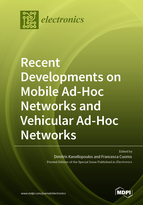Recent Developments on Mobile Ad-Hoc Networks and Vehicular Ad-Hoc Networks
A special issue of Electronics (ISSN 2079-9292). This special issue belongs to the section "Networks".
Deadline for manuscript submissions: closed (30 November 2020) | Viewed by 21312
Special Issue Editors
Interests: multimedia networks; quality of service (QoS) in multimedia networks; mobile ad hoc networks; wireless networks; wireless sensor networks; computer networks design, modeling, and implementation
Special Issues, Collections and Topics in MDPI journals
Interests: vehicular and sensor networks; low power wide area networks and IoT; cognitive radio networks; multimedia networking; energy saving in the Internet and in the wireless system
Special Issues, Collections and Topics in MDPI journals
Special Issue Information
Dear Colleagues,
Mobile ad-hoc networks (MANETs) are deployed mainly in emergency situations like natural disasters and battlefields as there is no need to deploy any infrastructure to make nodes to communicate with each other. The topology of MANET changes dynamically due to the movement of the nodes and the resulting route failures and re-computations, difficulty in maintaining sessions, and so on. Each MANET node typically maintains the information of delay, jitter, loss rate stability, and distance for each link in order to feed routing algorithms. However, this state information is inherently imprecise due to the changes in the topology and the fact that resources such as bandwidth, battery, processing, and storage are limited. These peculiar characteristics of MANETs complicate quality of service (QoS) provision and, thus, multimedia communication over MANETs. In the last decade, much research effort has been devoted to addressing various challenges such as (1) effective QoS-based routing protocols and congestion control mechanisms for MANETs, (2) effective TDMA scheduling algorithms that guarantee QoS provisioning over MANETs by reducing the end-to-end delay and drop rate, (3) video streaming over MANETs, and (4) tools that evaluate MANET performance.
This Special Issue solicits novel work in terms of solutions and techniques for MANETs. We look forward to creating a forum in which researchers in the domain of MANETs can share their results, techniques, surveys, analyses, and discussions on the problems of MANETs. Topics of interest for this Special Issue are not limited strictly to traditional MANET problems, but also ones that address related fields, including vehicular ad-hoc networks (VANETs) and the use of UAV (Unmanned Aerial Vehicles), such as (but not limited to) the following:
- Network architectures and protocols for MANETs
- QoS-based routing for MANETs or VANETs
- Congestion control for MANETs or VANETs
- QoS scheduling for MANETs or VANETs
- MAC protocols for MANETs or VANETs
- Transmission techniques for multimedia information over MANETs or VANETs
- Effective QoS control mechanisms for MANETs
- 5G platforms for MANETs and VANETs
- UAV assisted MANETs and VANETs
- Security for MANETs or VANETs
Dr. Dimitris Kanellopoulos
Assoc. Prof. Dr. Francesca Cuomo
Guest Editors
Manuscript Submission Information
Manuscripts should be submitted online at www.mdpi.com by registering and logging in to this website. Once you are registered, click here to go to the submission form. Manuscripts can be submitted until the deadline. All submissions that pass pre-check are peer-reviewed. Accepted papers will be published continuously in the journal (as soon as accepted) and will be listed together on the special issue website. Research articles, review articles as well as short communications are invited. For planned papers, a title and short abstract (about 100 words) can be sent to the Editorial Office for announcement on this website.
Submitted manuscripts should not have been published previously, nor be under consideration for publication elsewhere (except conference proceedings papers). All manuscripts are thoroughly refereed through a single-blind peer-review process. A guide for authors and other relevant information for submission of manuscripts is available on the Instructions for Authors page. Electronics is an international peer-reviewed open access semimonthly journal published by MDPI.
Please visit the Instructions for Authors page before submitting a manuscript. The Article Processing Charge (APC) for publication in this open access journal is 2400 CHF (Swiss Francs). Submitted papers should be well formatted and use good English. Authors may use MDPI's English editing service prior to publication or during author revisions.
Keywords
- Network protocols for MANETs
- Routing for MANETs or VANETs
- Congestion control for MANETs or VANETs
- Transmission techniques for multimedia information over MANETs or VANETs
- QoS control mechanisms for MANETs
- UAV assisted MANETs and VANETs
- Security for MANETs or VANETs







